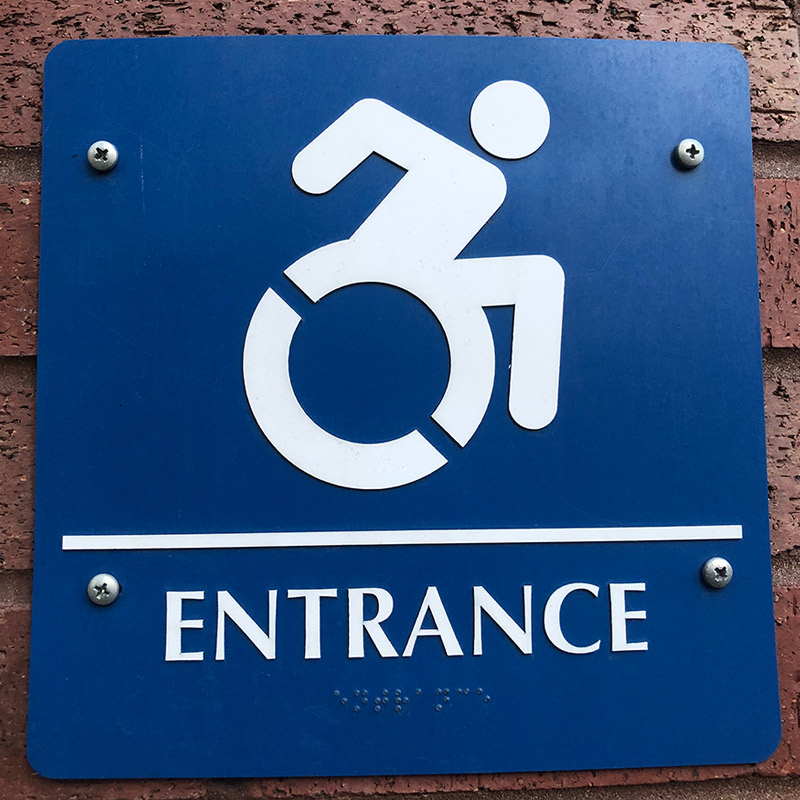How ADA Signs Enhance Availability for Everyone
How ADA Signs Enhance Availability for Everyone
Blog Article
How ADA Signs Change Rooms for Individuals With Impairments
The transformation of spaces through ADA indicators for individuals with impairments is a profound testament to the power of availability. By adhering to ADA compliance, settings end up being risk-free and navigable, with indicators that function necessary components like high-contrast shades and Braille, consequently enhancing visibility and understanding.

Significance of ADA Conformity
Ensuring ADA compliance is not just a legal responsibility but likewise a social commitment to inclusivity and ease of access. By sticking to the guidelines stated in the Americans with Disabilities Act (ADA), organizations show their commitment to producing settings where individuals with impairments can involve and navigate without barriers. ADA compliance is essential in removing discrimination, cultivating equal rights, and promoting self-reliance for people with handicaps.
Companies and public establishments benefit dramatically from ADA compliance. It aids them stay clear of lawful fines and enhances their credibility by showcasing their commitment to diversity and incorporation. By making sure centers are obtainable to everybody, organizations can bring in a more comprehensive consumer base, consisting of the 61 million Americans living with handicaps. This inclusivity extends past simple compliance, showing a proactive position towards accessibility.
Furthermore, ADA conformity is a keystone of universal design, which emphasizes creating spaces that accommodate all individuals, no matter their capabilities. By implementing compliant signage and attributes, companies add to a more fair culture, where all members can participate completely. Inevitably, ADA conformity goes beyond lawful responsibility, symbolizing a societal value that prioritizes empowerment and equivalent chance for everyone.
Enhancing Navigation and Security
Browsing areas with confidence and safety and security is vital for people with impairments, and ADA-compliant signs plays a critical duty in achieving this objective. These indications are developed with details attributes to accommodate the varied requirements of individuals with various handicaps, consequently assisting in smoother and more secure navigating throughout public and personal spaces. By giving clear, standard details, ADA indicators decrease complication and promote a greater sense of independence for individuals who count on them.
The tactical positioning of ADA indicators guarantees that important info comes to everyone, including those with visual, auditory, or cognitive impairments. Responsive and Braille elements on indications aid aesthetically damaged individuals separately situate leaves, washrooms, and various other key areas. In emergency situations, ADA signs contribute to efficient evacuations by clearly marking fire escape and paths, hence boosting safety and security for all owners.
In addition, ADA-compliant signs foster an inclusive setting by resolving the special navigating difficulties dealt with by individuals with specials needs. This not just aids in their personal safety and security yet also motivates participation in societal activities by advertising equal access to civil services and centers. Ultimately, effective ADA signs changes areas right into obtainable, risk-free, and welcoming settings for every person.
Features of Efficient ADA Indications
To produce effective ADA indications, it is crucial to incorporate certain features that attend to the diverse availability demands of individuals with disabilities. One important attribute is the use of high-contrast shades, which significantly enhance presence for people with aesthetic disabilities.
An additional important attribute is tactile components, such as raised characters and Braille, promoting access for aesthetically damaged people. The raised characters need to be at least 1/32 inch over the surface, allowing for simple touch analysis. Braille needs to be positioned straight below matching text, making certain uniformity and ease of navigation.
The placement of ADA indicators is additionally essential for their performance. They should be mounted at an elevation in between 48 to 60 inches from the ground to guarantee they are available for people in wheelchairs or those with flexibility help. Moreover, indicators need to be situated near bathrooms, entrances, and lifts, ensuring that critical information is accessible specifically when required. By incorporating these functions, ADA indicators can substantially boost wayfinding and availability for all.
Influence On Area Addition
ADA signs significantly contribute to area addition by making sure that public areas are navigable and easily accessible for individuals with specials needs. These signs, created in compliance with the Americans with Disabilities Act (ADA), attribute tactile aspects, braille, and high-contrast colors, assisting not only those with aesthetic problems but a varied range of impairments - ADA Signs. Because of this, they play a critical role in developing environments where people with handicaps can take part fully and separately resource in area life

In addition, ADA indicators aid organizations and businesses fulfill lawful commitments, thereby preventing potential discrimination claims and boosting their credibilities as inclusive entities. Ultimately, ADA signs are indispensable tools in the recurring initiative to construct more easily accessible and fair neighborhoods for every person.
Future Trends in Accessible Signage
How will technical improvements shape the future of available signage? The assimilation of advanced innovations promises to change exactly how individuals with disabilities communicate with their environments. One encouraging development is using smart and electronic signs that can dynamically adjust material to satisfy private requirements. For instance, electronic signs outfitted with sensing units and connection can engage with personal gadgets to offer personalized info, such as text-to-speech for aesthetically impaired individuals or streamlined graphics for those Our site with cognitive impairments.
Increased reality (AR) likewise holds considerable capacity. AR applications can overlay digital details onto real-world settings, providing individuals with improved navigational aids and contextual info (ADA Signs). This can be specifically helpful in complicated setups like airport terminals or huge public venues where typical signs might fail
Another arising pattern is the unification of Net of Things (IoT) innovation to develop a network of interconnected indicators. This permits real-time updates and enhanced access, adapting to adjustments in the environment or user needs. Additionally, with the expanding focus on inclusivity, future laws might promote even a lot more advanced signage solutions, making sure global gain access to and promoting a much more comprehensive culture for all individuals.
Conclusion
ADA signs play an important role in transforming spaces for people with handicaps by ensuring ease of access and advertising independence. Conformity with ADA requirements enhances navigating and safety and security with using high-contrast shades, responsive components, and Braille. These functions promote community page incorporation and encourage individuals by developing barrier-free environments. The continual development of accessible signs guarantees additional improvements in inclusivity, ultimately boosting the general experiences of people with specials needs and reinforcing their feeling of belonging in community life.
The change of areas through ADA signs for individuals with handicaps is a profound testimony to the power of accessibility.To produce effective ADA indications, it is imperative to incorporate certain attributes that address the diverse accessibility needs of individuals with specials needs.ADA indicators considerably contribute to area inclusion by making sure that public areas are accessible and obtainable for people with disabilities.By assisting in the simplicity of motion and understanding within public areas, ADA indications promote a feeling of belonging and empowerment amongst individuals with disabilities.ADA indicators play a crucial role in transforming rooms for people with handicaps by making certain accessibility and advertising freedom.
Report this page